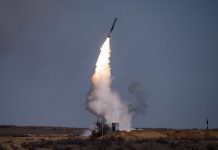Taipei’s usually busy streets will come to a halt on Thursday when air raid sirens send thousands of people into underground shelters in a rehearsal for a Chinese attack.
The annual civilian drill is being held in cities across Taiwan this week, alongside military training, to prepare the self-governed island for a potential invasion by China.
While Communist China has never ruled Taiwan, Beijing insists the island is part of its territory and has threatened to use force to bring it under its control.
At 1:30 pm (0530 GMT), sirens will be heard across Taipei, bringing the capital city of 2.5 million people to a halt for half an hour.
Traffic will be required to stop, and people will be directed into shelters, including underground car parks and subway stations.
The drills will also involve simulating wartime aid distribution and a mass-casualty event.
Since taking office last year, Taiwanese President Lai Ching-te has sought to raise public awareness of the threat posed by China.
Of the drills, 25-year-old Oscar Wang said: “I think this is necessary because tensions across the strait are so high right now.”
“So it’s important to let us ordinary people become more familiar with evacuation routes,” he told AFP.
Taiwan is also keen to demonstrate to the world, especially its key security backer, Washington, that it is serious about enhancing its defense capability. Taiwanese regular troops were joined by the largest-ever mobilisation of reservists for the 10-day “Han Kuang” military drills, which end Friday.
Rather than only repelling a Chinese attack on its shores, Taiwanese troops this year have also practised fighting invading forces in city streets.
“It is as much training as acclimating the Taiwanese population to the reality of modern warfare,” said Kitsch Liao of the Atlantic Council, a US think tank.
Heavily armed troops carrying US-provided anti-aircraft Stinger missiles stormed Taipei’s metro system in a night-time exercise.
High-tech mobile missile launchers from the United States have also been positioned around the capital and elsewhere, in full view of the public.
And shoppers in a Taipei supermarket recently became participants in a drill simulating a Chinese missile strike on the city.
“I didn’t know there was going to be a drill,” Yang Shu-ting, 70, told AFP.
“My heart was beating very fast, and I was inevitably nervous. I think the point is to let you know where you should hide if something happens.”
Troops have also simulated various scenarios, including “grey zone harassment” — tactics that fall short of an act of war — and “long-range precision strikes”, defence officials have said.
Several minor collisions involving military vehicles during the exercises highlighted the challenge of manoeuvring through Taiwan’s narrow streets.
Defence expert Chieh Chung said such mishaps were “difficult to avoid” in urban areas.
“In Taiwan, many roads and bridges create significant limitations for armoured vehicles when they move through,” said Chieh, a researcher at the Association of Strategic Foresight in Taipei.
“So this becomes a problem and obstacle for both attacking and defending forces.”

Japan Concerned
Japan said on Tuesday that China’s intensifying military activities could “seriously impact” its security, citing the first confirmed incursion by a Chinese military aircraft into its airspace in an annual threat assessment.
The defence ministry stated in its white paper that China was intensifying its activities in the entire region surrounding Japan.
A Chinese military aircraft entered Japan’s airspace in August last year, it said. Then, in September, a Chinese aircraft carrier and two other naval ships sailed between two Japanese islands near Taiwan.
Beijing’s military “created a situation that could seriously impact Japan’s security”, the paper said.
It repeated its comment from last year’s paper that China’s military ambitions pose “an unprecedented and (the) greatest strategic challenge” to Japan and the world.
Beijing responded by saying the paper “hypes up the so-called China threat”.
“China expresses strong dissatisfaction and firm opposition to this and has lodged solemn representations with Japan,” China’s foreign ministry spokesman Lin Jian said.
Tokyo said last week that Chinese fighter jets flew within 30 metres (100 feet) of a Japanese military patrol aircraft over the East China Sea.
Last year, Chinese vessels sailed near the Japanese-administered Senkaku islands — known as the Diaoyu in China — a record 355 times, according to Tokyo.
And last month Japan said that two Chinese aircraft carriers sailed in the Pacific simultaneously for the first time, including in Japan’s economic waters.
China called it “routine training”.
Beijing has also conducted joint drills with Russia which are “clearly intended as a demonstration of force against Japan”, the paper said.
It repeated that North Korea’s activities pose a “more grave and imminent threat to Japan’s national security than ever before”.
The white paper was approved by the cabinet of Prime Minister Shigeru Ishiba on Tuesday.
– Japan boosts defence spending –
Japan is in a multi-year process of increasing its defence spending.
It is bolstering its military ties with Washington — and other regional US allies — to make US and Japanese forces nimbler in response to threats such as a Chinese invasion of Taiwan.
The Pentagon is pressing Japan and Australia to make clear what role they would play if the United States and China went to war over Taiwan, the Financial Times reported on Saturday.
Elbridge Colby, US under-secretary of defence for policy, has been pushing the issue in meetings with Japanese and Australian defence officials in recent months, the FT said.
Colby said that President Donald Trump’s “common sense agenda” included “urging allies to step up their defense spending and other efforts related to our collective defense”.
“Of course, some among our allies might not welcome frank conversations,” Colby wrote on X.
The issue also forms parts of negotiations between Tokyo and Washington on a trade deal to avert 25-percent tariffs on Japanese imports due from August 1.
© Agence France-Presse




